Eritrea Volcanoes
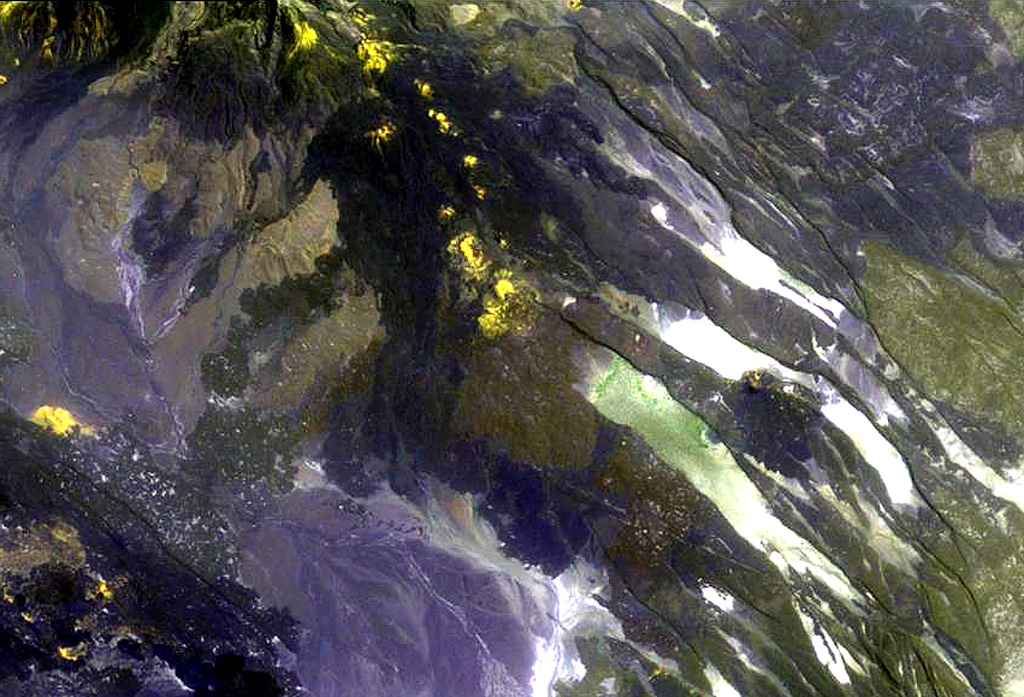
Eritrea has 8 Holocene volcanoes. Note that as a scientific organization we provide these listings for informational purposes only, with no international legal or policy implications. Volcanoes will be included on this list if they are within the boundaries of a country, on a shared boundary or area, in a remote territory, or within a maritime Exclusive Economic Zone. Bolded volcanoes have erupted within the past 20 years. Suggestions and data updates are always welcome ().
| Volcano Name | Last Eruption | Volcanic Region | Primary Landform |
|---|---|---|---|
| Alid | Unknown - Evidence Credible | Afar Rift Volcanic Province | Composite |
| Assab Volcanic Field | Unknown - Evidence Credible | Afar Rift Volcanic Province | Cluster |
| Dubbi | 1861 CE | Afar Rift Volcanic Province | Composite |
| Gufa | Unknown - Evidence Credible | Afar Rift Volcanic Province | Cluster |
| Mallahle | Unknown - Evidence Uncertain | Afar Rift Volcanic Province | Composite |
| Mousa Alli | Unknown - Evidence Credible | Afar Rift Volcanic Province | Composite |
| Nabro | 2012 CE | Afar Rift Volcanic Province | Composite |
| Sork Ale | Unknown - Evidence Uncertain | Afar Rift Volcanic Province | Composite |
Chronological listing of known Holocene eruptions (confirmed or uncertain) from volcanoes in Eritrea. Bolded eruptions indicate continuing activity.
| Volcano Name | Start Date | Stop Date | Certainty | VEI | Evidence |
|---|---|---|---|---|---|
| Nabro | 2011 Jun 13 | 2012 Jun 3 (?) | Confirmed | 4 | Observations: Reported |
| Dubbi | [1900 (?)] | [Unknown] | Uncertain | ||
| Dubbi | [1863] | [Unknown] | Uncertain | ||
| Dubbi | 1861 May 8 | 1861 Oct (?) | Confirmed | 3 | Observations: Reported |
| Dubbi | 1400 Jul 15 ± 45 days | Unknown | Confirmed | 2 | Observations: Reported |
Eritrea has 1 Pleistocene volcanoes. Note that as a scientific organization we provide these listings for informational purposes only, with no international legal or policy implications. Volcanoes will be included on this list if they are within the boundaries of a country, on a shared boundary or area, in a remote territory, or within a maritime Exclusive Economic Zone. Suggestions and data updates are always welcome ().
| Volcano Name | Volcanic Region | Primary Landform |
|---|---|---|
| Mabda | Afar Rift Volcanic Province | Minor |
There are 18 photos available for volcanoes in Eritrea.
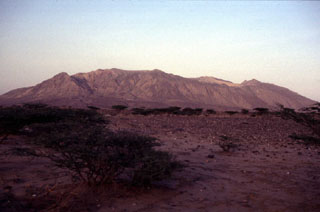 The elongated Alid volcano, which sits on the axis of the Danakil spreading center, is seen here from the W. Most of the flanks of the volcano in this view are composed of dipping rhyolitic lava flows; the light-colored area along the right skyline is rhyolitic pumice. The summit of the volcano is elongated in an E-W direction and contains a 1 x 1.5 km wide, 100-m-deep crater at the western end. Vast lava fields originating from fissure vents in the Alid graben extend to the NW and SE of the volcano. Vigorous fumarolic activity continues at Alid.
The elongated Alid volcano, which sits on the axis of the Danakil spreading center, is seen here from the W. Most of the flanks of the volcano in this view are composed of dipping rhyolitic lava flows; the light-colored area along the right skyline is rhyolitic pumice. The summit of the volcano is elongated in an E-W direction and contains a 1 x 1.5 km wide, 100-m-deep crater at the western end. Vast lava fields originating from fissure vents in the Alid graben extend to the NW and SE of the volcano. Vigorous fumarolic activity continues at Alid.Photo by Wendell Duffield, 1996 (U.S. Geological Survey).
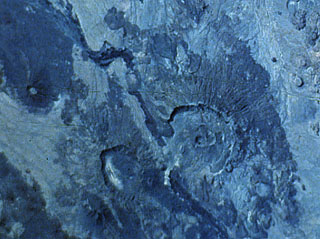 The smaller (left-hand) of the two large calderas at the bottom center of this NASA Space Shuttle image is Mallahle. The steep-walled 8-km-wide caldera truncates a stratovolcano. Basaltic lava flows blanket the slopes of the volcano, and flank vents are most numerous on its western side. Mallahle lies SW of the larger Nabro caldera (right-center) and is the central of three NE-SW-trending stratovolcanoes in the Danakil horst SW of Dubbi volcano.
The smaller (left-hand) of the two large calderas at the bottom center of this NASA Space Shuttle image is Mallahle. The steep-walled 8-km-wide caldera truncates a stratovolcano. Basaltic lava flows blanket the slopes of the volcano, and flank vents are most numerous on its western side. Mallahle lies SW of the larger Nabro caldera (right-center) and is the central of three NE-SW-trending stratovolcanoes in the Danakil horst SW of Dubbi volcano.NASA Space Shuttle image S-61A-36, 1985 (http://eol.jsc.nasa.gov/).
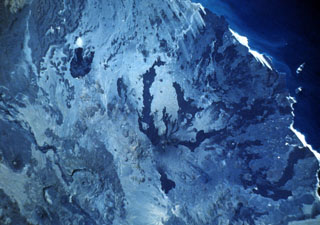 Dark-colored lava flows radiate away from the summit of Dubbi volcano in this Space Shuttle image with the Red Sea at the upper right. The two most recent eruptions were fed by fissure systems that extend NW-SE and NNE-SSW. The former produced lava flows that reached the Red Sea in 1400 CE. Lava flows from the 1861 eruption traveled as far as 22 km to the east and also reached the coast.
Dark-colored lava flows radiate away from the summit of Dubbi volcano in this Space Shuttle image with the Red Sea at the upper right. The two most recent eruptions were fed by fissure systems that extend NW-SE and NNE-SSW. The former produced lava flows that reached the Red Sea in 1400 CE. Lava flows from the 1861 eruption traveled as far as 22 km to the east and also reached the coast.Photo S-61A-36, 1985 (National Aeronautical and Space Administration).
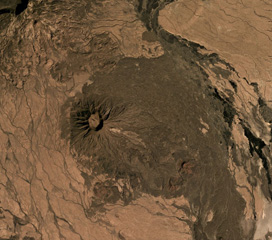 Sork Ale is part of the Nabro Volcanic Range between the Danakil Depression and the Red Sea. The 1,100 x 1,200 m, 300-m-deep crater is near the center of this December 2019 Planet Labs satellite image mosaic (N is at the top). Darker eroded lava flows form the flanks and the lighter areas to the NE and SW are ignimbrite deposits from large explosive eruptions.
Sork Ale is part of the Nabro Volcanic Range between the Danakil Depression and the Red Sea. The 1,100 x 1,200 m, 300-m-deep crater is near the center of this December 2019 Planet Labs satellite image mosaic (N is at the top). Darker eroded lava flows form the flanks and the lighter areas to the NE and SW are ignimbrite deposits from large explosive eruptions.Satellite image courtesy of Planet Labs Inc., 2019 (https://www.planet.com/).
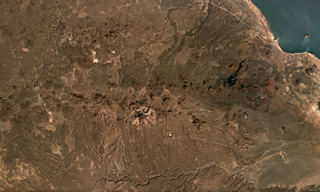 The chain of scoria cones and lava flows extending along an E-W trend in this December 2019 Planet Labs satellite image mosaic is the Assab volcanic field near the Red Sea coast in southern Eritrea (N is at the top; this image is approximately 58 km across). This field covers an area roughly 55 x 90 km, with lava flows reaching the Red Sea to the E, including to the coastal city of Assab.
The chain of scoria cones and lava flows extending along an E-W trend in this December 2019 Planet Labs satellite image mosaic is the Assab volcanic field near the Red Sea coast in southern Eritrea (N is at the top; this image is approximately 58 km across). This field covers an area roughly 55 x 90 km, with lava flows reaching the Red Sea to the E, including to the coastal city of Assab.Satellite image courtesy of Planet Labs Inc., 2019 (https://www.planet.com/).
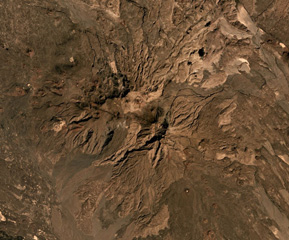 Mousa Alli is located on the border of Ethiopia, Eritrea, and Djibouti, and is seen here in this December 2019 Planet Labs satellite image mosaic (N is at the top; this image is approximately 21 km across). The main edifice in the center has undergone extensive erosion and there are scoria cones and lava flows on the SE and NW flanks.
Mousa Alli is located on the border of Ethiopia, Eritrea, and Djibouti, and is seen here in this December 2019 Planet Labs satellite image mosaic (N is at the top; this image is approximately 21 km across). The main edifice in the center has undergone extensive erosion and there are scoria cones and lava flows on the SE and NW flanks.Satellite image courtesy of Planet Labs Inc., 2019 (https://www.planet.com/).
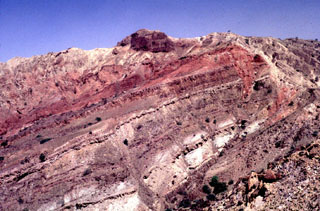 Uplift at Alid has exposed thick sequences of reddish, well-stratified siltstone beds, some very fossiliferous, which accumulated in a tidal or inter-tidal environment. High in the sequence there are some pillow basalts. At the very top of the sequence on the left is a few-meters-thick cover of light-colored rhyolitic Plinian pumice fallout.
Uplift at Alid has exposed thick sequences of reddish, well-stratified siltstone beds, some very fossiliferous, which accumulated in a tidal or inter-tidal environment. High in the sequence there are some pillow basalts. At the very top of the sequence on the left is a few-meters-thick cover of light-colored rhyolitic Plinian pumice fallout.Photo by Wendell Duffield, 1996 (U.S. Geological Survey).
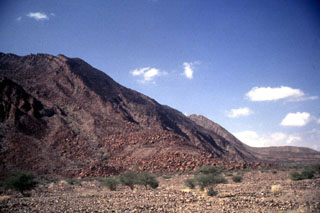 The lower SE flank of Alid consists of a series of rhyolitic lava flows of late-Pleistocene age. The uppermost units are lava flows of basaltic-to-andesitic composition. These rocks were uplifted by a silicic magma body that was intruded into the upper crust of the Danakil Depression during the Pleistocene.
The lower SE flank of Alid consists of a series of rhyolitic lava flows of late-Pleistocene age. The uppermost units are lava flows of basaltic-to-andesitic composition. These rocks were uplifted by a silicic magma body that was intruded into the upper crust of the Danakil Depression during the Pleistocene.Photo by Wendell Duffield, 1996 (U.S. Geological Survey).
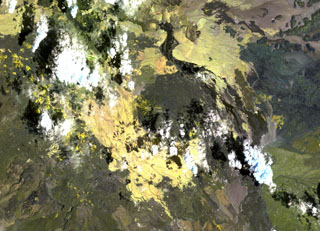 The roughly 1-km-wide caldera is located at the western side of the dark-colored lava field, at the summit of Sork Ale volcano (at the center of this NASA Landsat image, N is at the top). This stratovolcano, also known as Asdaga, is located perpendicular to the orientation of three larger stratovolcanoes trending NE-SW at the southern end of the Danakil Alps. The ages of recent eruptions are not certain.
The roughly 1-km-wide caldera is located at the western side of the dark-colored lava field, at the summit of Sork Ale volcano (at the center of this NASA Landsat image, N is at the top). This stratovolcano, also known as Asdaga, is located perpendicular to the orientation of three larger stratovolcanoes trending NE-SW at the southern end of the Danakil Alps. The ages of recent eruptions are not certain.NASA Landsat image, 1999 (courtesy of Hawaii Synergy Project, Univ. of Hawaii Institute of Geophysics & Planetology).
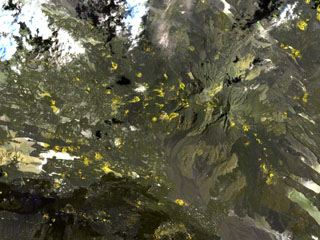 Mousa Alli volcano dominates the right-hand side of this NASA Landsat image and is located on the border between Ethiopia, Eritrea, and Djibouti. This volcano is the most prominent topographic feature in this area and towers above its neighbor to the SW, Manda Inakir, visible at the lower left. Yellow-colored basaltic pyroclastic cones and associated lava flows occupy the SE and NW flanks.
Mousa Alli volcano dominates the right-hand side of this NASA Landsat image and is located on the border between Ethiopia, Eritrea, and Djibouti. This volcano is the most prominent topographic feature in this area and towers above its neighbor to the SW, Manda Inakir, visible at the lower left. Yellow-colored basaltic pyroclastic cones and associated lava flows occupy the SE and NW flanks.NASA Landsat image, 1999 (courtesy of Hawaii Synergy Project, Univ. of Hawaii Institute of Geophysics & Planetology).
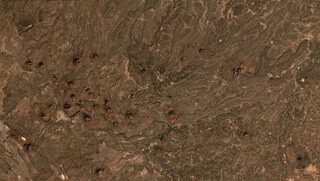 The Gufa volcanic field NE of Mousa Alli volcano extends from the Djibouti border (bottom left) into Eritrea, seen here in this December 2019 Planet Labs satellite image mosaic (N is at the top; this image is approximately 23 km across). Many scoria cones and lava flows are visible withing the broad field aligned in an E-W direction.
The Gufa volcanic field NE of Mousa Alli volcano extends from the Djibouti border (bottom left) into Eritrea, seen here in this December 2019 Planet Labs satellite image mosaic (N is at the top; this image is approximately 23 km across). Many scoria cones and lava flows are visible withing the broad field aligned in an E-W direction.Satellite image courtesy of Planet Labs Inc., 2019 (https://www.planet.com/).
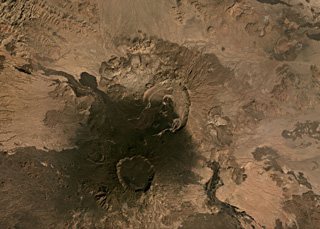 This November 2019 Planet Labs satellite image monthly mosaic shows several calderas and lava flows, with Nabro in the center and Mallahle below it, both within the Bidu Volcanic Complex of the Nabro Volcanic Range (N is at the top). The 6-km-diameter-wide Mallahle caldera contains obsidian lava flows in the northern part. Sork’Ale is partly visible to the SE.
This November 2019 Planet Labs satellite image monthly mosaic shows several calderas and lava flows, with Nabro in the center and Mallahle below it, both within the Bidu Volcanic Complex of the Nabro Volcanic Range (N is at the top). The 6-km-diameter-wide Mallahle caldera contains obsidian lava flows in the northern part. Sork’Ale is partly visible to the SE.Satellite image courtesy of Planet Labs Inc., 2019 (https://www.planet.com/).
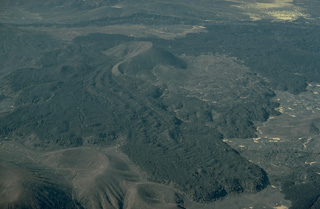 A lava flow with prominent flow levees issued from a breached cinder cone in the Mousa Alli volcanic complex. This large Holocene stratovolcano was constructed along the border between Ethiopia, Eritrea, and Djibouti and towers above its neighbor to the SW, Manda Inakir. Rhyolitic lava domes and lava flows are found in the summit region, which is truncated by a caldera.
A lava flow with prominent flow levees issued from a breached cinder cone in the Mousa Alli volcanic complex. This large Holocene stratovolcano was constructed along the border between Ethiopia, Eritrea, and Djibouti and towers above its neighbor to the SW, Manda Inakir. Rhyolitic lava domes and lava flows are found in the summit region, which is truncated by a caldera.Copyrighted photo by Katia and Maurice Krafft, 1976.
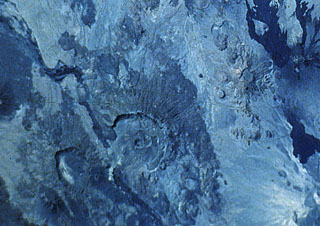 The large caldera below and to the left of the center of this Space Shuttle photo of the Danakil Alps of Ethiopia is Nabro. This volcano is the highest in the Danakil depression and is truncated by nested calderas 10 and 5 km in diameter. The larger caldera is breached to the SW. The 8-km-wide Mallahle caldera is at the lower left, and the dark-colored lava flows at the right are from Dubbi volcano.
The large caldera below and to the left of the center of this Space Shuttle photo of the Danakil Alps of Ethiopia is Nabro. This volcano is the highest in the Danakil depression and is truncated by nested calderas 10 and 5 km in diameter. The larger caldera is breached to the SW. The 8-km-wide Mallahle caldera is at the lower left, and the dark-colored lava flows at the right are from Dubbi volcano.NASA Space Shuttle image S-61A-36, 1985 (http://eol.jsc.nasa.gov/).
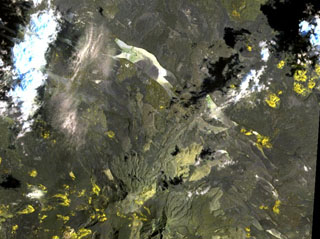 The yellow-colored pyroclastic cones at the upper right lie along the western part of the Gufa volcanic field, which extends from the Djibouti border into Eritrea (upper right). These basaltic scoria cones and lava flows are aligned in an E-W direction NE of Mousa Alli volcano, a large stratovolcano that is visible at the bottom center of this NASA Landsat image. A second E-W-trending chain of cones, not visible in this image, is located to the north of the principal chain in Eritrea and fed long lava flows that descend in the direction of the Red Sea.
The yellow-colored pyroclastic cones at the upper right lie along the western part of the Gufa volcanic field, which extends from the Djibouti border into Eritrea (upper right). These basaltic scoria cones and lava flows are aligned in an E-W direction NE of Mousa Alli volcano, a large stratovolcano that is visible at the bottom center of this NASA Landsat image. A second E-W-trending chain of cones, not visible in this image, is located to the north of the principal chain in Eritrea and fed long lava flows that descend in the direction of the Red Sea.NASA Landsat image, 1999 (courtesy of Hawaii Synergy Project, Univ. of Hawaii Institute of Geophysics & Planetology).
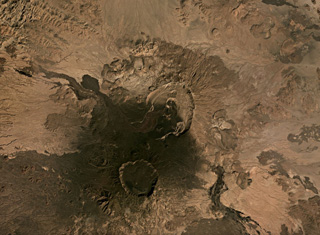 This November 2019 Planet Labs satellite image monthly mosaic shows several calderas and lava flows, with Nabro in the center and Mallahle below it within the Bidu Volcanic Complex (N is at the top). The 8-km-wide Nabro summit caldera opens towards the S, and the darker lava flow towards the NWW was erupted in 2011.
This November 2019 Planet Labs satellite image monthly mosaic shows several calderas and lava flows, with Nabro in the center and Mallahle below it within the Bidu Volcanic Complex (N is at the top). The 8-km-wide Nabro summit caldera opens towards the S, and the darker lava flow towards the NWW was erupted in 2011.Satellite image courtesy of Planet Labs Inc., 2019 (https://www.planet.com/).
 The chain of pyroclastic cones and lava flows extending diagonally down from the upper-left portion of this Landsat image is the southern portion of the Mousa Alli volcanic complex. The flanks of its neighbor to the SW, Manda Inakir, are visible at the extreme lower left. Prominent faults at the right cut lava flows of the Pliocene-Pleistocene stratoid series of the Afar region.
The chain of pyroclastic cones and lava flows extending diagonally down from the upper-left portion of this Landsat image is the southern portion of the Mousa Alli volcanic complex. The flanks of its neighbor to the SW, Manda Inakir, are visible at the extreme lower left. Prominent faults at the right cut lava flows of the Pliocene-Pleistocene stratoid series of the Afar region.NASA Landsat image, 1999 (courtesy of Hawaii Synergy Project, Univ. of Hawaii Institute of Geophysics & Planetology).
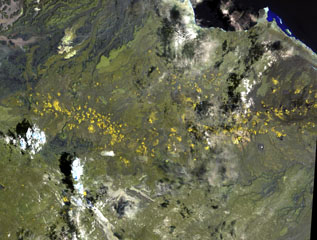 The long chain of pyroclastic cones and lava flows extending E-W across this Landsat image is the Assab volcanic field near the Red Sea coast in southern Eritrea. This spectacular range of basaltic cinder cones and associated lava flows covers a 55 x 90 km area, and flows reached the Red Sea along a broad front. The vents were constructed along a broad E-W-trending line that extends to the coastal city of Assab, out of view to right.
The long chain of pyroclastic cones and lava flows extending E-W across this Landsat image is the Assab volcanic field near the Red Sea coast in southern Eritrea. This spectacular range of basaltic cinder cones and associated lava flows covers a 55 x 90 km area, and flows reached the Red Sea along a broad front. The vents were constructed along a broad E-W-trending line that extends to the coastal city of Assab, out of view to right.NASA Landsat image, 1999 (courtesy of Hawaii Synergy Project, Univ. of Hawaii Institute of Geophysics & Planetology).
This is a compilation of Eritrea volcano information sources, such as official monitoring or other government agencies.
| Volcanic Ash Advisory Center |
|---|
| Toulouse Volcanic Ash Advisory Center (VAAC) Notices and Archive |
